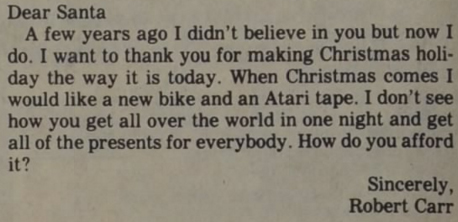

"Where's the Tape?"
By Scott Stilphen

In the late 1980s, when I started perusing the classifieds in local newspapers, I noticed most listings for Atari systems and games referred to cartridges as "tapes". I figured it was a 'local' thing, as I didn't recall seeing them referred to as such in ads. But, thanks to the digital archives at Newspapers.com, not only were classified ads using that terminology back then, several businesses were as well:


ShopRite ad from the
June 15th, 1982 edition of The Citizens'
Voice newspaper.


Ads from The Citizens'
Voice newspaper:
(LEFT) Boscov's ad from the October 10th, 1982
edition; (RIGHT) Main Liquidating ad from the
November 22nd, 1982 edition.
Although the earliest published account of it in my area was 1982, expanding my search showed the use of "tapes" was commonplace throughout the country. Here's the earliest example I could find, from a California-based newspaper:

Woolco ad from the December 1st, 1977 edition of The
Sacramento Bee newspaper.
Similar examples can also be found in countless articles as well. And lest you think only adults were the only ones guilty of this...

A letter from the December 9th, 1982 edition of the Tustin
News newspaper.
So, even as soon as a few months after the VCS was released, the incorrect terminology was already starting to take hold. The question is, why, and how did it begin?
For a brief time (staring in the late 1960s), the 8-track was a popular format for music. Although it was developed after the compact cassette and offered less fidelity in a larger package, it didn't require being rewound or 'flipped over'. When Fairchild was designing their Video Entertainment System (AKA the Channel F), they turned to Mechanical Engineer Ron Smith to develop the system's cartridge interface, based on Smith's previous experience designing a removable memory module for a prototype calculator, the Novus 7100. Smith hired a contract engineer, Doug Hardy, to help with designing the cartridge mechanism (Hardy left before the project was completed and went to Atari, helping to develop the cartridge shell and mechanism for the VCS, as well as helping Atari avoid any possible patent infringement over the Fairchild's designs). Fairchild marketed their cartridges as 'videocarts'. An Industrial Designer by the name of Nick Talesfore was tasked with creating the shell for the game cartridges. Talesfore looked to the 8-track for inspiration and designed a similarly-shaped plastic shell, for here was a similar device that held fragile material susceptible to damage that was widely used.


Although they might look similar, you'll hear a
different 'eruption' if you insert an 8-track into your Channel F.
Even though the Channel F was a commercial failure, it was on the market at the same time the VCS was (actually beating the VCS to market the year before). So for that reason, it's easy to see how and why game cartridges were sometimes called "tapes", and that carried over to subsequent consoles that came onto the market (Odyssey2, Intellivision, Colecovision, etc). The growing segment of home computer owners who used cassette drives for data storage further drove the commonality of referring to any plastic storage devices as "tapes"; there are a few references to game cartridges being referred to as cassettes as well.

Jewelcor ad from the
November 25th, 1982 edition of The Citizens'
Voice newspaper.

Partial article from the July 3rd, 2016 edition of The Citizens'
Voice newspaper.
Prior to the Channel F, there was the Compucolor 8001 computer by Intelligent Systems Corp. (ISC) which originally used a floppy-tape drive - one or two external 8-track, continuous-loop tape drives, running at 4800 Baud rate, storing up to 1024 KB of data per tape - but due to poor performance, these were later replaced with 8" floppy disk drives.

There also was the Cassette Vision system by Epoch which, despite the name, used cartridges. It seems "cassette" is synonymous for ROM cartridge in Japan.